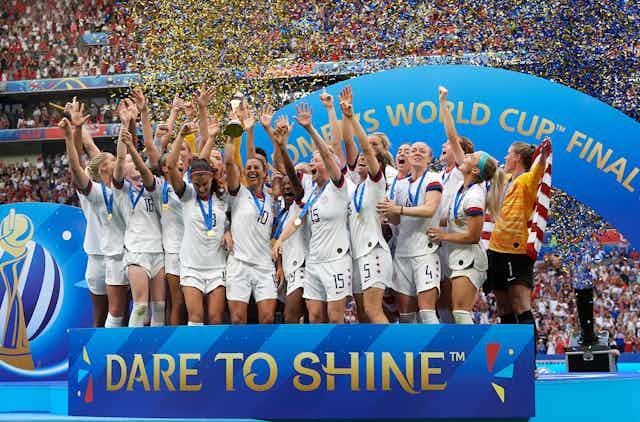There have been some good wins recently for women’s sport attendance in the UK, with a record-breaking crowd for a rugby match at Twickenham and a sold-out Emirates stadium for a Uefa Champions League football semi-final.
Less encouraging is Fifa’s suggestion that this summer’s women’s football World Cup, hosted by Australia and New Zealand, may not be available to TV viewers across Europe. Apparently the amount broadcasters are willing to pay to show it in the UK, Germany, Italy, Spain and France is too low. (Elsewhere in the world most of the rights contracts for the event have already been agreed.)
So is Fifa standing up for women’s football, or merely engaged in a bluffing tactic designed to boost its own revenue?
Certainly the organisation believes that women’s football is more commercially valuable now than it ever has been.
After years of selling collective broadcast rights for both men’s and women’s tournaments, in 2021 Fifa announced that the rights to its women’s World Cups would be sold separately. “Unbundling”, as it is known, only usually happens when a less valuable product becomes valuable enough to sell on its own, rather than as part of a bundle.
And the logic is clear. The rise of interest in women’s football (attendance and broadcasting) has been meteoric, with England’s Women’s Super League overall attendance increasing more than 600% in five years (excluding the season which coincided with COVID lockdowns). The same Arsenal women’s Champions League fixture which recently sold out the Emirates Stadium had an attendance figure of just 1,406 a decade before.
There has also been a notable increase in both private and public investment in female teams and players at club and national levels. And European financial regulations exempt spending on women’s football from their rules concerning club losses to encourage this form of spending.
Foul play?
But despite the surge in viewing figures and financial investment, there is an argument that broadcasters have been sluggish to catch up with demand in women’s football.
Some of those broadcasters will respond that as businesses, they need to make a profit. They will bid to broadcast popular events so they can sell advertising space or subscriptions, and with any sale, organisations will offer the lowest amount they think they can get away with. Those offers also depend on how much competitors are willing to spend as multiple bidders create an environment that pushes up prices.
Yet the bids for this summer’s global tournament have apparently come in at between 1% and 10% of the level reached for the men’s World Cup, which Fifa said was between US$100 million and US$200 million (£79 million and £158 million).
One reason for the low bids may be to do with how audience numbers are affected by the day of the week and time of broadcast. There is evidence that the impact of scheduling (for example, evenings and weekends) on TV audiences is crucial.
In the coming Women’s World Cup, for example, England’s group stage matches would be shown in the UK on a Saturday at 9.30am, a Friday at 10.30am and a Tuesday at midday. Later on, the semi-finals would be shown on a Tuesday at 8am, a Wednesday at 11am and the final on Sunday at 11am.
To European broadcasters, a small time zone difference in match schedules would likely mean a higher value on the Women’s World Cup 2023 rights. For the men’s tournament, the TV audience in the UK was much higher for France in 1998 and Germany in 2006 than it was for the 2002 tournament hosted by Japan and South Korea.
In the meantime, for the growing number of fans of women’s football, the uncertainty over broadcasting rights this summer is surely unwelcome. And the negotiating tactic by Fifa to try increase bids is not a very strong one.

Failing the women’s game?
Broadcast income matters to Fifa; in their latest four-year cycle, 45% of its income was from TV broadcasting, and of that, 31% came from Europe. This mainly relates to the men’s World Cup, but it does tell us how dependent Fifa is on European broadcasters. And some income is surely better than no income at all.
If the broadcasters refuse to budge, and Fifa’s threatened blackout happens? Well, viewers will still be able to watch coverage of the World Cup on Fifa’s own streaming channel.
Meanwhile, Fifa will risk accusations of failing the women’s game rather than supporting it.
“Globalising competitions” and “accelerating the growth of women’s football” are part of FIFA’s own strategy. So not allowing access to viewers in growing markets for women’s football would be a strange thing to do, especially when its own accounts show that spending on women’s football promotion made up less than 1% of its development and education programme spending.
So, while women’s football does remain undervalued, there is plenty more that Fifa could be doing to improve the situation, preferably without threatening to exclude millions of its strongest supporters.
To impose a European broadcasting blackout on a global tournament that deserves to be in the spotlight would be seen by many as a spectacular own goal.

